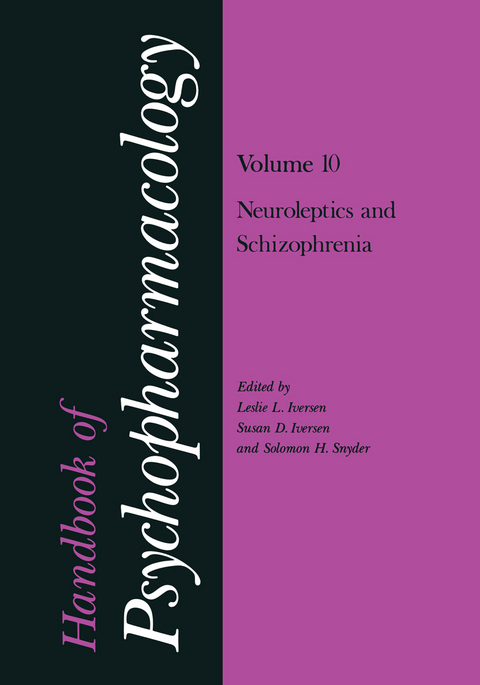
Handbook of Psychopharmacology
Springer-Verlag New York Inc.
978-1-4613-4044-7 (ISBN)
Crane's chapter deals with tardive dyskinesia and other neurological side effects. Fielding and Lal discuss behavioral studies in animals which provide models for assessing the drugs' therapeutic efficacy. Janssen and Van Bever deal with the remarkable structure-activity relationships of the butyrophenones, the most potent and selective neuroleptics which were almost single-handedly devel- oped through the brilliant efforts of Paul Janssen. Shore and Giachetti describe basic and clinical features of reserpine, the neurotransmitter effects of which differ from .
1 Structure-Activity Relationships of the Butyrophenones and Diphenylbutylpiperidines.- 1. Introduction.- 2. Structure-Activity Relationships.- 3. Pharmacology.- 4. Conclusion.- 5. References.- 2 Biochemical Actions of Neuroleptic Drugs: Focus on the Dopamine Receptor.- 1. Introduction.- 2. Early Biochemical Studies.- 3. Dopamine Metabolism and Neuroleptics.- 4. The Dopamine-Sensitive Adenylate Cyclase.- 5. Labeling the Dopamine Receptor.- 6. References.- 3 Behavioral Actions of Neuroleptics.- 1. Introduction.- 2. Effect on Feeding and Drinking.- 3. Locomotor Activity and Catalepsy.- 4. Antiamphetamine Action.- 5. Avoidance Behavior.- 6. Brain Self-Stimulation.- 7. Aggression.- 8. Narcotic-Withdrawal Syndrome.- 9. Conclusions.- 10. References.- 4 Neuroleptics: Clinical Use in Psychiatry.- 1. Introduction.- 2. The Methodology of Drug Studies.- 3. Efficacy of Antipsychotic Drugs.- 4. Maintenance Treatment with Antipsychotic Medication.- 5. Cost of Medication and Dispensing.- 6. Antipsychotic Drugs and Somatic Therapies.- 7. Drug Combinations.- 8. Drug, Psychological, and Social Treatments.- 9. New Antipsychotic Drugs.- 10. References.- 5 Tardive Dyskinesia and Related Neurologic Disorders.- 1. Historical Background.- 2. Clinical Findings.- 3. Predisposing Factors.- 4. Drug Effects.- 5. Severity and Combinations of Symptoms.- 6. Disability and Complications.- 7. Differential Diagnosis.- 8. Pathophysiology.- 9. Neuropharmacology.- 11. Concluding Remarks.- 12. References.- 6 Reserpine: Basic and Clinical Pharmacology.- 1. Introduction.- 2. Source, History, and Analogs.- 3. Distribution and Metabolism.- 4. Pharmacological Effects in Laboratory Animals.- 5. Clinical Pharmacology.- 6. Biochemical Mechanism of Action.- 7. Interaction of Reserpine with Other Centrally Acting Drugs.- 8. The Reserpine Receptor.- 9. References.- 7 Neurotransmitter Theories of Schizophrenia.- 1. Introduction.- 2. Survey of Neurotransmitter Theories.- 3. General Principles Underlying Neurotransmitter Theories in Psychiatry.- 4. Attention in Schizophrenia and Its Pharmacology.- 5. References.
| Zusatzinfo | XII, 250 p. |
|---|---|
| Verlagsort | New York, NY |
| Sprache | englisch |
| Maße | 170 x 244 mm |
| Themenwelt | Sachbuch/Ratgeber ► Natur / Technik ► Garten |
| Geisteswissenschaften ► Psychologie | |
| Medizin / Pharmazie ► Medizinische Fachgebiete ► Pharmakologie / Pharmakotherapie | |
| Medizin / Pharmazie ► Medizinische Fachgebiete ► Psychiatrie / Psychotherapie | |
| Medizin / Pharmazie ► Pharmazie | |
| ISBN-10 | 1-4613-4044-6 / 1461340446 |
| ISBN-13 | 978-1-4613-4044-7 / 9781461340447 |
| Zustand | Neuware |
| Haben Sie eine Frage zum Produkt? |
aus dem Bereich


